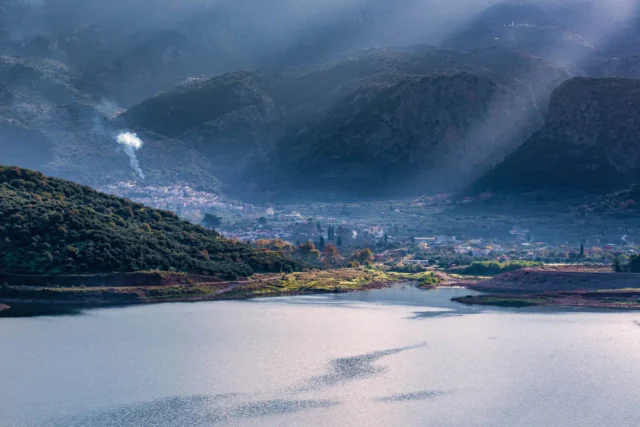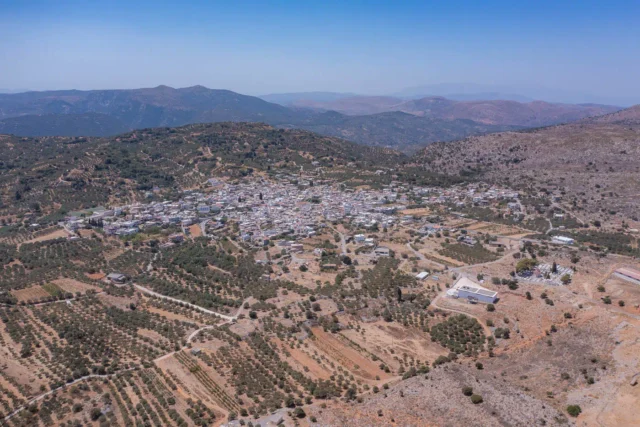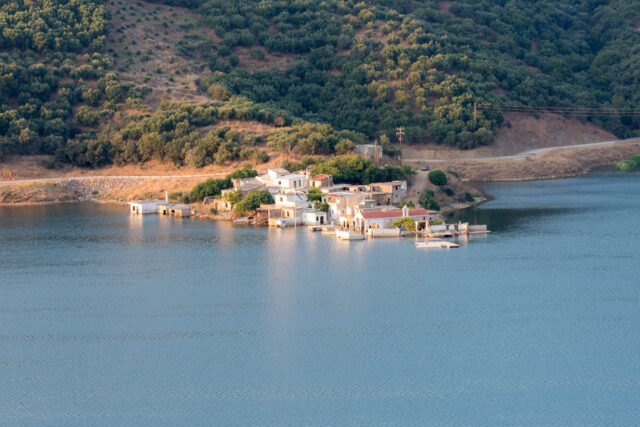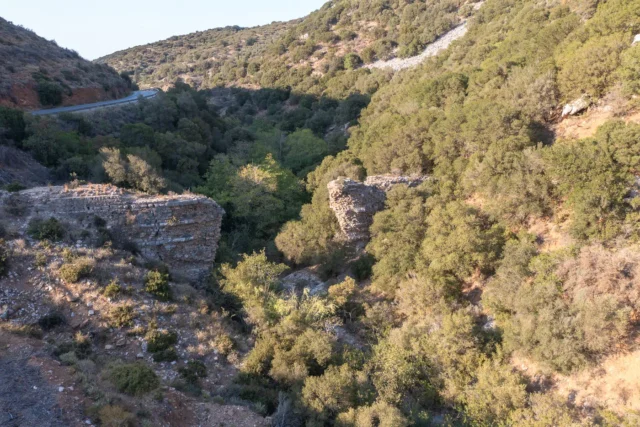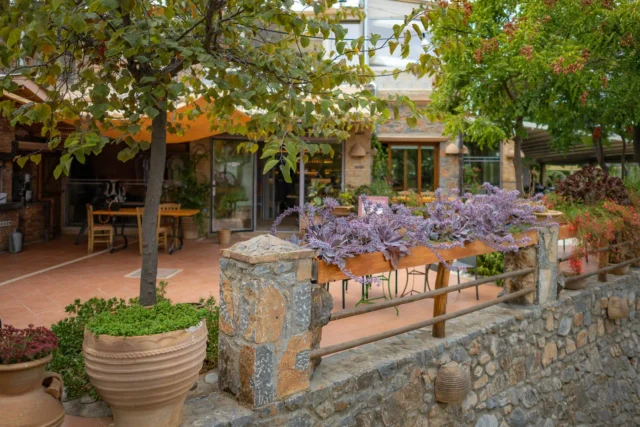
Aitania, Chersonissos
Aitania, a village in Heraklion, Crete, is 20 km from Heraklion. Its name is believed to be a corruption of the ancient city of Diatonion. Aitania is recorded in a Venetian document from 1212 as "Icania." The Venetian census of 1583 lists it as "Itagnia Cato" with 112 inhabitants and "Itagnia Apano" with 85 inhabitants. On October 12, 1856, a major earthquake with a magnitude of 8.2 struck Crete, causing significant damage and resulting in the death of 40 people in Aitania. In 1954, archaeologist N. Platon excavated a small, cave-like carved tomb west of Aitania at a site called "Fonias." The tomb contained approximately thirty Geometric period vessels. The village square is a central gathering point for residents and visitors, with traditional cafes. The Cultural Association of Aitania organizes a Cretan feast in the square every year on August 15th.

Amnisos Sanctuary of Zeus Thenatas
The Sanctuary of Zeus Thenatas at Amnisos, located on the north-central coast of Crete near Heraklion, is an archaeological site with a rich history spanning from the Bronze Age to the Early Iron Age. The sanctuary is dedicated to Zeus Thenatas, a deity associated with both Minoan and Mycenaean traditions. Amnisos, mentioned in Homer's Odyssey, was a significant center for maritime activities and trade during the Bronze Age. Excavations have revealed a 44-meter-long ashlar wall, smaller podia, and a thick layer of ash and burnt animal bones, suggesting animal sacrifice and ritual feasting. Votive offerings include bronze tripods, figurines, miniature weapons, and terracotta figurines of bulls and horses. The sanctuary exemplifies the continuity and change in Cretan religious practices, with the site's dedication to Zeus Thenatas reflecting Minoan traditions, while the adoption of new votive practices and the presence of faience objects highlight the evolving nature of religious expression. The sanctuary was operational from the Protogeometric period (c. 900 BC) to the end of the Early Iron Age (c. 600 BC), with two main phases of use marked by the construction of two temples: Temple A (Late Subminoan period to around 800 BC) and Temple B (around 800 BC to c. 600 BC).

Amnisos Villa of the Lilies
Amnissos, an ancient Minoan port city located on Crete's north coast, boasts the luxurious Villa of the Lilies. This two-story villa, constructed with ashlar blocks during the Middle Minoan IIIA period (around the 17th century BC), features a hall with multiple doors, a bathroom, stairs, and covered paved areas. Its name comes from the frescoes of lilies that once decorated its walls. The villa, excavated in 1932 by Spyridon Marinatos, was likely destroyed by an earthquake or tidal wave around 1500 BC. Amnissos is also significant for its mythological connection to Zeus, whose omphalos (navel) is said to have fallen there. The area was referred to as the Omphalian Plain. The name Amnissos appears in Linear B inscriptions, indicating its importance to the Minoan civilization. The presence of the harbor, various buildings, and an open-air archaic sanctuary dedicated to Zeus further underscores its historical significance.

Chersonissos, Herronissos (Ancient)
Chersonissos is an ancient Greek city located on the northern coast of Crete. It was inhabited as early as the Minoan period and continued to flourish under the Romans and Byzantine eras. The city served as the port of Lyttos, an inland city, and was an important center for trade and commerce. Archaeological excavations have revealed a number of significant structures, including a theater, early Christian basilicas, and harbor remains. The city's history is reflected in its coins, which feature various deities and symbols. Chersonissos is now a popular tourist destination, known for its beautiful beaches, ancient ruins, and lively nightlife.

Episkopi, Chersonissos
Episkopi, a village near Heraklion, Crete, has a long history dating back to the Minoan era. The village's name, meaning "bishopric", reflects its role as the seat of the Bishop of Hersonissos after the Byzantine era. It has numerous Byzantine and post-Byzantine churches, including the 11th-century Panagia Kera-Limniotissa and the 14th-century Agios Ioannis with Venetian-era frescoes. Episkopi also has a war museum and a municipal park.

Kainourgio Chorio, Chersonissos
Kainourgio Chorio, a historic village in Crete, boasts a rich history dating back to the Second Byzantine period. Despite its name, meaning "New Village," it has a long and storied past evident in its well-preserved landmarks. The village, located in the Municipality of Hersonissos, is nestled at an altitude of 220 meters. Kainourgio Chorio is home to the Foscolo Tower, a Venetian-era fortified residence that later underwent modifications during the Ottoman occupation. The village also houses the Church of Panagia and Agia Paraskevi, adorned with surviving fragments of frescoes from the Venetian period. The Venetian wine presses, some of the largest in Crete, stand as a testament to the region's historical wine production. The Wine Museum, donated by Ioannis Papadakis, offers a glimpse into the region's winemaking heritage, showcasing preserved wine production facilities and a collection of wines.

Karfi archaeological site
Karphi, a Late Minoan IIIC refuge village in Crete, perched high above the Lasithi Plateau, offers a glimpse into Minoan resilience during a time of upheaval. Excavated in the late 1930s, the site reveals a planned settlement with houses, streets, and evidence of diverse cult activities. Its strategic location provided a defensive advantage, offering panoramic views of the Lasithi plain and north-central Crete. The village likely served as a refuge for Minoans seeking safety and survival after the collapse of the Minoan palaces. Despite the harsh conditions, the village featured paved streets, yards, and single-story houses, suggesting a planned and organized community. Karphi stands out for its diverse and widespread cult activities, with shrines dedicated to goddesses and various ritual artifacts. The Temple served as the central focus for ritual activities, housing goddess figures, snake tubes, braziers, and fireboxes. Other areas, such as the Commercial Quarter and the Great House Shrine, also contained evidence of cult practices. Rooms containing offering stands, figurines, and libation vessels indicate that rituals were not confined to formal shrines, suggesting a more informal setting for community offerings. This decentralized approach to ritual practices distinguishes Karphi from other LM IIIC sites.



